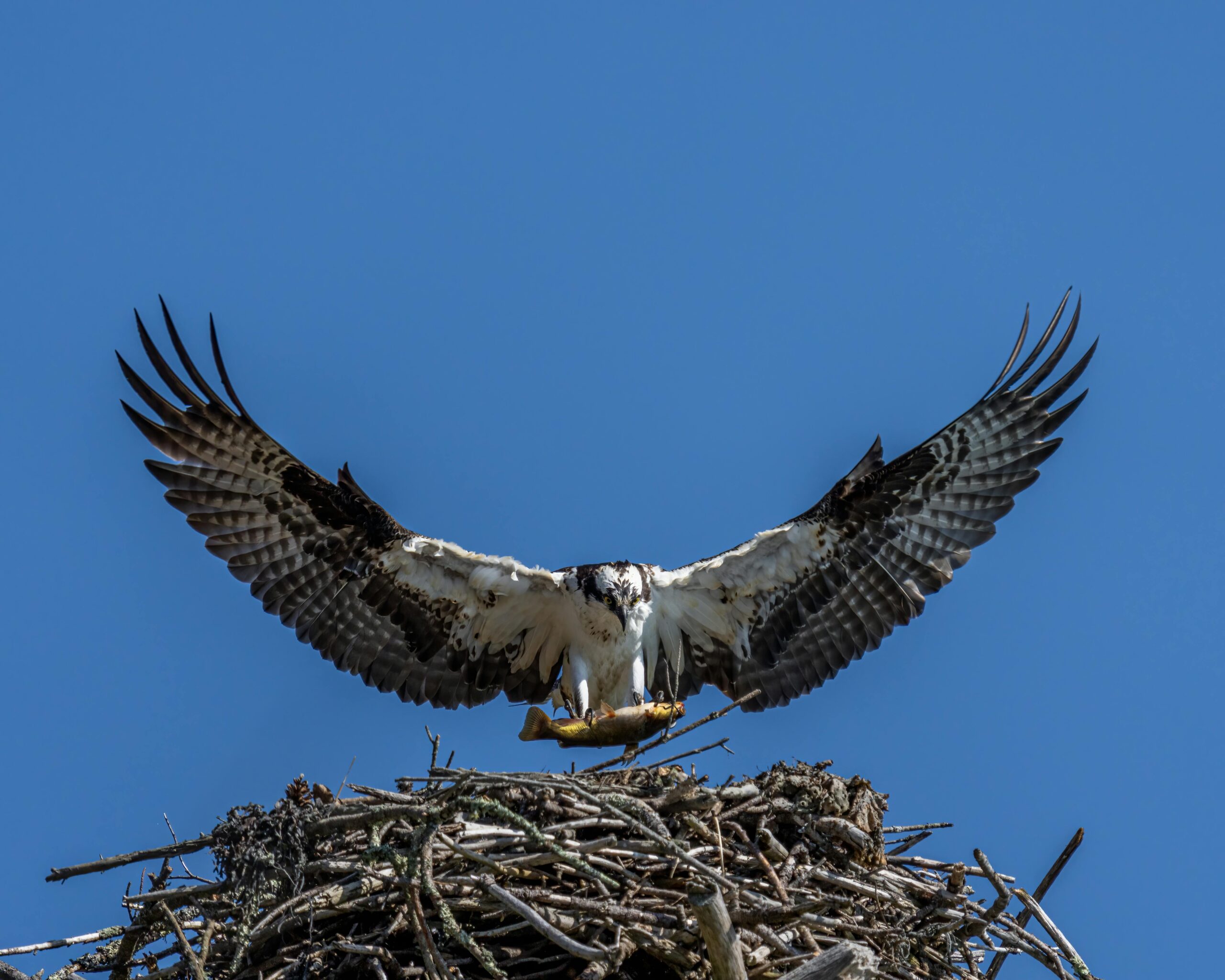Ospreys, also known as fish hawks, are majestic birds of prey widely recognized for their distinctive nesting behavior. One of the most intriguing aspects of their lifestyle is their strong preference for building nests on elevated perches such as tall trees, cliffs, utility poles, and specially designed platforms. These high vantage points are not random choices but reflect a combination of evolutionary adaptation, environmental awareness, and instinctual behaviour.
By nesting high above ground, ospreys enhance their ability to detect potential threats, access nearby water bodies efficiently, and reduce competition for space and safety. Their unique nesting preferences offer critical insight into their survival strategies and interaction with changing habitats. Understanding these patterns not only enriches our knowledge of osprey ecology but also supports more effective conservation and habitat management efforts.
Nesting Behavior and Seasonal Patterns
Ospreys exhibit highly predictable nesting behaviours that are closely tied to seasonal shifts and regional climate conditions. In most regions of North America, ospreys begin their migration back from wintering grounds in Central and South America during early spring. As they return, they instinctively seek out familiar nesting sites—often reusing old nests year after year. This site fidelity is common among mature breeding pairs and plays a crucial role in strengthening pair bonds and ensuring reproductive success.
Their preference for elevated, open platforms allows them to establish territory quickly, often deterring other birds from encroaching. The seasonal timing of nesting aligns precisely with the abundance of prey, particularly fish, in nearby aquatic environments. Ospreys tend to select nest sites near productive water bodies, ensuring easy access to food during the energy-intensive breeding season.
Key behaviors include:
- Early return to nesting sites in spring
- Aggressive territorial displays to protect nest area
- Regular maintenance and enlargement of existing nests
- Synchronization with fish spawning periods for optimal feeding
This seasonal rhythm is vital for successful rearing of chicks and long-term population sustainability.
Breeding Cycle and Nesting Timeline
The osprey’s breeding cycle is methodical and follows a well-defined timeline. Once a pair reunites at their chosen nesting site, courtship and mating behaviors begin, typically involving aerial displays and vocalizations. Soon after mating, the female lays between 2 to 4 eggs, usually spaced a day or two apart. The incubation period spans about 35 to 42 days, during which the female incubates while the male provides food.
After hatching, the chicks go through several key growth stages:
- Week 1–2: Chicks remain under constant brooding; both parents are active in feeding
- Week 3–5: Feather development begins; chicks become more alert and active
- Week 6–8: Wing-flapping and short hovering practice starts
- Week 8–10: Fledging occurs; young birds begin short flights near the nest
By late summer, juvenile ospreys become independent and begin their migration south. This full cycle—from arrival to fledging—typically spans five months and is repeated annually, reflecting the osprey’s deep connection to seasonal cycles and high-perch nesting habits.
Habitat Selection and Environmental Factors
Ospreys are habitat specialists that display a strong preference for nesting in environments that provide safety, stability, and reliable food access. Their selection process is largely dictated by three key factors: elevation, proximity to water, and the level of human disturbance. Elevated nest sites—ranging from tall trees and cliff edges to man-made structures like power poles and nesting platforms—offer broad visibility and physical separation from ground-based predators.
Additionally, ospreys are more likely to establish nests in open landscapes with minimal canopy cover. This ensures unobstructed flight access, which is essential for carrying fish back to the nest and monitoring threats. Regions with an abundance of shallow, fish-rich waters such as lakes, rivers, estuaries, and coastal marshes are particularly attractive to these raptors.
Typical environmental preferences include:
- High perching locations with structural stability
- Clear flight paths around the nesting site
- Consistent food supply within a 5 km radius
- Limited human interference or disturbance
This finely tuned site selection reflects the osprey’s reliance on both natural features and adaptive use of human-made landscapes for survival and reproduction.
Importance of Proximity to Water Bodies
The osprey’s survival strategy is inseparable from its dependence on aquatic ecosystems. As piscivores, ospreys consume almost exclusively live fish, making proximity to water bodies a non-negotiable criterion for nesting. Ideal nesting locations are within close range of rivers, lakes, bays, or coastal zones that support a stable fish population.
Their ability to dive feet-first into the water, aided by reversible outer toes and barbed footpads, allows for efficient hunting, but repeated long-distance foraging would impose unsustainable energy costs—especially during chick-rearing. Being close to water minimizes this burden and increases the likelihood of successful feeding trips.
Key benefits of water proximity include:
- Reduced energy expenditure during foraging
- Faster feeding cycles for growing chicks
- Enhanced success rates for fledgling survival
- Year-over-year nest site fidelity near productive fisheries
In modern landscapes, artificial water reservoirs and fish-rich urban wetlands have also become nesting hotspots, showing the osprey’s ability to adapt within certain ecological limits.
Advantages of Elevated Nesting Sites
One of the most defining characteristics of osprey nesting behavior is their preference for high, open nesting locations. This instinctual choice is deeply rooted in evolutionary advantages that contribute to their reproductive success and chick survival. Elevated nests provide superior visibility of the surrounding landscape, allowing ospreys to detect potential threats well in advance and to monitor the activities of nearby prey.
Additionally, high perches minimize the risk of interference from ground predators such as raccoons, snakes, and other egg-eating animals. The strategic height also reduces competition from other bird species that may seek to occupy or disrupt the nest. With few natural predators able to access such heights, elevated nesting sites offer a level of security vital to the vulnerable early stages of chick development.
Core advantages of high nests include:
- Wide field of view for predator detection
- Enhanced safety for eggs and fledglings
- Reduced nest competition from terrestrial species
- Optimized angles for take-off and landing during hunting
These benefits highlight how nest elevation plays a critical role in osprey ecology and contributes directly to their high breeding success rates.
Protection from Predators and Human Disturbance
Ospreys face threats not only from natural predators but increasingly from human activity. Nesting at high elevations serves as a buffer against both. Urban expansion, recreational activities near waterways, and industrial development pose constant disturbances to ground-nesting or low-perching bird species. However, ospreys that choose to nest on tall trees, transmission towers, or artificial platforms are generally better insulated from these disruptions.
These elevated locations help:
- Deter ground predators like raccoons, snakes, and opossums
- Avoid human encroachment, such as construction or boat traffic
- Minimize noise pollution and vibrations that could stress chicks
- Support long-term use, as many high sites remain undisturbed
In areas where human structures are common, ospreys have adapted by nesting on communication towers and specially installed poles. These sites not only mirror the security of natural high perches but often allow wildlife managers to monitor and protect active nests with ease.
Nest Construction Techniques
Ospreys are known for building large, conspicuous nests that reflect both their intelligence and adaptability. Whether atop a natural tree snag or a man-made platform, nest construction is a highly collaborative process between male and female. The male typically gathers materials, while the female arranges them to shape the structure and prepare a suitable lining for egg-laying.
Nest-building starts with a foundation of sturdy materials such as large sticks and branches, followed by finer twigs, grasses, moss, and even man-made debris. Ospreys often return to the same nest each year, adding new layers and repairs, resulting in massive structures that can exceed a meter in depth and diameter.
Key elements of nest construction include:
- Building on stable, elevated platforms
- Using natural and synthetic materials based on availability
- Reusing and reinforcing existing nests each season
- Modifying structure in response to weather and damage
These construction techniques showcase the osprey’s ingenuity and highlight their role as long-term ecosystem inhabitants.
Materials Used and Nest Maintenance
The materials ospreys use in nest building are both functional and opportunistic. Their primary structural components—large sticks and branches—form a stable base. Over time, the interior is lined with softer elements like seaweed, bark, grass, and even plastic bags or fishing line, particularly in human-dominated landscapes. This adaptability can be both beneficial and hazardous, especially when synthetic debris entangles chicks or destabilizes nests.
Maintenance is an ongoing task. Ospreys often conduct mid-season repairs, especially after storms or high winds. During the breeding season, new materials are added regularly, not just for structural integrity but also for parasite management and thermal insulation.
Common nesting materials include:
- Structural: Sticks, driftwood, tree bark
- Insulation: Moss, grass, algae, seaweed
- Man-made debris: Fishing line, fabric, plastics (increasingly common)
While their use of urban materials highlights their flexibility, it also underscores the importance of keeping nesting areas clean and free of hazardous waste. Wildlife conservation programs often monitor nest contents to reduce the risk of entanglement and promote safe breeding.
Conservation Efforts and Habitat Protection
Osprey populations, once in serious decline due to pesticide use and habitat destruction, have experienced a notable rebound thanks to targeted conservation efforts and habitat protection measures. In the mid-20th century, the widespread use of DDT led to eggshell thinning and reduced hatch rates, pushing osprey numbers dangerously low in many regions. Since the banning of DDT and increased public awareness, conservationists have worked diligently to restore osprey habitats and support breeding success.
Key elements of these recovery initiatives include legal protection under migratory bird acts, habitat restoration, public education, and nest monitoring programs. In many regions, local communities participate in tracking nest success and reporting sightings, contributing to data collection and ecological stewardship.
Conservation strategies include:
- Protection of nesting sites through regulation and signage
- Monitoring of nest success and chick development
- Public outreach and education on osprey ecology
- Coordination between wildlife agencies and energy companies
These efforts have led to the recovery of osprey populations across North America and Europe, showcasing the power of collaborative wildlife conservation.
Role of Artificial Nesting Platforms
One of the most successful interventions in osprey conservation is the use of artificial nesting platforms. These human-made structures mimic the height, openness, and stability of natural perches, providing ospreys with safe and predictable nesting sites. Often placed on poles near lakes, rivers, or reservoirs, these platforms help mitigate the loss of natural nesting habitats due to logging, development, or climate change.
Artificial platforms serve multiple purposes:
- Encourage safe nesting away from hazardous electrical poles
- Support site fidelity, with birds returning year after year
- Reduce conflicts with utility infrastructure and human activity
- Enable monitoring, offering researchers easier access for banding and data collection
Many utility companies now work with conservation groups to install these platforms on power lines or decommissioned poles, turning potential threats into osprey-friendly habitats. The integration of artificial nesting structures into osprey ecology is a leading example of adaptive conservation design in practice.

